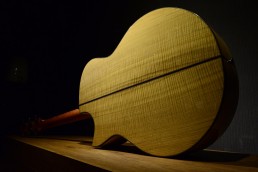Much like how the ingredients dictate the type of dish, the tonewood used in building an instrument will significantly impact how it sounds. We sat down with Hozen to learn more about his approach in choosing the wood and possible pairings. “I think about the final sound objectives, speed of sound, and the look of the grain,” Hozen shared.
“I think about the final sound objectives, speed of sound, and the look of the grain,” Hozen sharing about his approach on choosing tonewoods.
Through the years, we have made instruments with various tonewood combinations, giving us a deeper understanding on how each tonewood interacts with another, ultimately impacting the tonal characteristics of the instrument. Below are some common wood used for back and sides, their characteristics, and our observations when paired with a specific soundboard.
INDIAN ROSEWOOD
On its own, Indian Rosewood sports a “scooped” response, with a clear bass response and a glassy treble. Because of this, it serves as a remarkably versatile tonewood for us to pick and choose the kind of tops we would pair it with. Pair it with a Western Red Cedar for its warmth and complexity, Sitka Spruce for its clear, percussive attack, and Adirondack Spruce for its refined trebles and robust midrange. Adirondack Spruce with Indian Rosewood
KHAYA MAHOGANY
Woody and transparent, Khaya Mahogany is a tonewood that exhibits great midrange response with strong fundamentals. When paired with a Khaya Mahogany top, these instruments possess a great deal of warmth with bell-like highs. Switching to a Western Red Cedar top gives these instruments a little more complexity by bringing overtones back into the mix with an extended bass response. Western Red Cedar with Khaya Mahogany
PACIFIC KOA
Pacific Koa possesses some of the sweetest treble response with more defined lower mids. This unique tone is further enhanced with an all Koa instrument, resulting in clear upper register that is not harsh with a more present lower registers. Another great pairing is with Adirondack Spruce for a wider frequency band and improved threshold. Full Pacific Koa
FLAMED MAPLE
Popular for its striking, “flamed” appearance, Flamed Maple has a strong upper register with clear mids and a strong presentation of the fundamental frequencies. This makes Flamed Maple a great pairing for both Adirondack Spruce and Western Red Cedar for balance in the bass registers and adding complexity with more overtones. Adirondack Spruce is typically chosen for its headroom and overall power while Western Red Cedar lends itself to a more delicate tone. Adirondack Spruce with Flamed Maple








